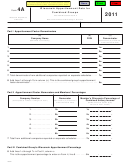Instructions For 2010 Form 4a: Wisconsin Apportionment Data For Combined Groups
ADVERTISEMENT
Instructions for 2010 Form 4A:
Wisconsin Apportionment Data for Combined Groups
schedules to list the additional members, their FEINs,
Purpose of Form 4A
and apportionment factor denominators as indicated
Combined groups that are engaged in business
in the table above. A combined group may use addi-
tional Forms 4A to report the additional companies or
within and outside Wisconsin use Form 4A to deter-
may create a separate schedule. Enter the total de-
mine the total Wisconsin share of the combined uni-
tary income and each member’s portion of that Wis-
nominators from the additional schedules on line 7a.
consin share.
■ Line 8a. Total Denominator for Combined
Group – This is the “common denominator” that each
The numerators and denominators reported on
member of the combined group will use to compute
Form 4A are based on the “modified sales factor”
its Wisconsin percentage in Part II.
apportionment method that is prescribed for com-
bined groups in sec. 71.255(5), Wis. Stats., and
s. Tax 2.61(7), Wisconsin Administrative Code.
The combined group files only one Form 4A with its
Part II: Apportionment Factor Numerators
combined return. Every combined return that is filed
by a combined group engaged in business within and
■ Lines 1b through 6c. Numerators by Company
outside Wisconsin must complete Form 4A and file it
with the combined return.
and Percentages – In column b, for each of the
companies you listed in Part I, in the order you listed
them in Part I, fill in the numerator of the company’s
modified sales factor.
Part I: Apportionment Factor Denominators
A member’s modified sales factor numerator may be
reported on any of the following lines of Form 4A-1 or
■
Lines
1
through
6a.
Denominators
by
Form 4A-2, as applicable:
Company – For each company in the combined
group (or for combined groups of more than six
members, for the first six members of the combined
Form
Part
Line
group), enter the company name and federal
Form 4A-1
I
16, col. a
identification number (FEIN) in columns a and b,
Form 4A-1
II
37, col. a
respectively.
Form 4A-1
III
15, col. a
In column c for each company, fill in the modified
Form 4A-1
IV
7, col. a
sales factor denominator computed on that com-
Form 4A-2
II
10
pany’s Form 4A-1, Wisconsin Apportionment Data for
Single Factor Formulas, or Form 4A-2, Wisconsin
In column c, enter the percentage computed by divid-
Apportionment Data for Multiple Factor Formulas.
ing the amount in column b by the common denomi-
The member’s modified sales factor denominator
nator in Part I, line 8a. Round to the nearest ten-
may be reported on any of the following lines of
thousandth of a percent.
Form 4A-1 or Form 4A-2, as applicable:
■ Line 7c. Additional Companies on Separate
Form
Part
Line
Schedules – If you prepared a separate schedule or
schedules for line 7a, use the same schedule(s) to
Form 4A-1
I
16, col. b
enter each company’s modified sales factor numera-
Form 4A-1
II
37, col. b
tor and the percentage computed by dividing that
Form 4A-1
III
15, col. b
numerator by the common denominator on line 8a.
Then add the percentages on the additional sched-
Form 4A-1
IV
7, col. b
ule(s) and enter the total percentage on line 7c.
Form 4A-2
II
8
■ Line 7a. Additional Companies on Separate
Schedules – If the combined group has more than
six members, attach an additional schedule or
IC-121
ADVERTISEMENT
0 votes
Related Articles
Related forms
Related Categories
Parent category: Financial
 1
1 2
2








